Early Childhood Education: Parent-Educator Discussion on Child Profile
VerifiedAdded on 2023/01/20
|9
|2195
|89
Project
AI Summary
This assignment presents a detailed child profile assessment and a simulated parent-educator discussion. The document begins with an interview script between an educator and a parent, Mr. Smith, discussing his 3-year-old daughter Martha's behavior and development at daycare. The educator explains the assessment methods used, including observations, play assessments, and the Early Years Learning Framework (EYLF). The assessment focuses on Martha's physical, cognitive, and sensory skills. The discussion highlights Martha's strengths, such as her interest in constructive play and music, and areas for improvement, like her gross motor skills and social interactions. Based on the findings, the educator provides recommendations for Martha's development, including increasing her gross motor skills through outdoor activities and supporting her creativity and problem-solving abilities. The document also references relevant theories and frameworks, such as Erikson's theory of psychosocial development and Bronfenbrenner's ecological systems theory. The assignment aims to demonstrate effective professional communication and the ability to discuss a child's learning profile with parents, including assessment methods, findings, and recommendations.
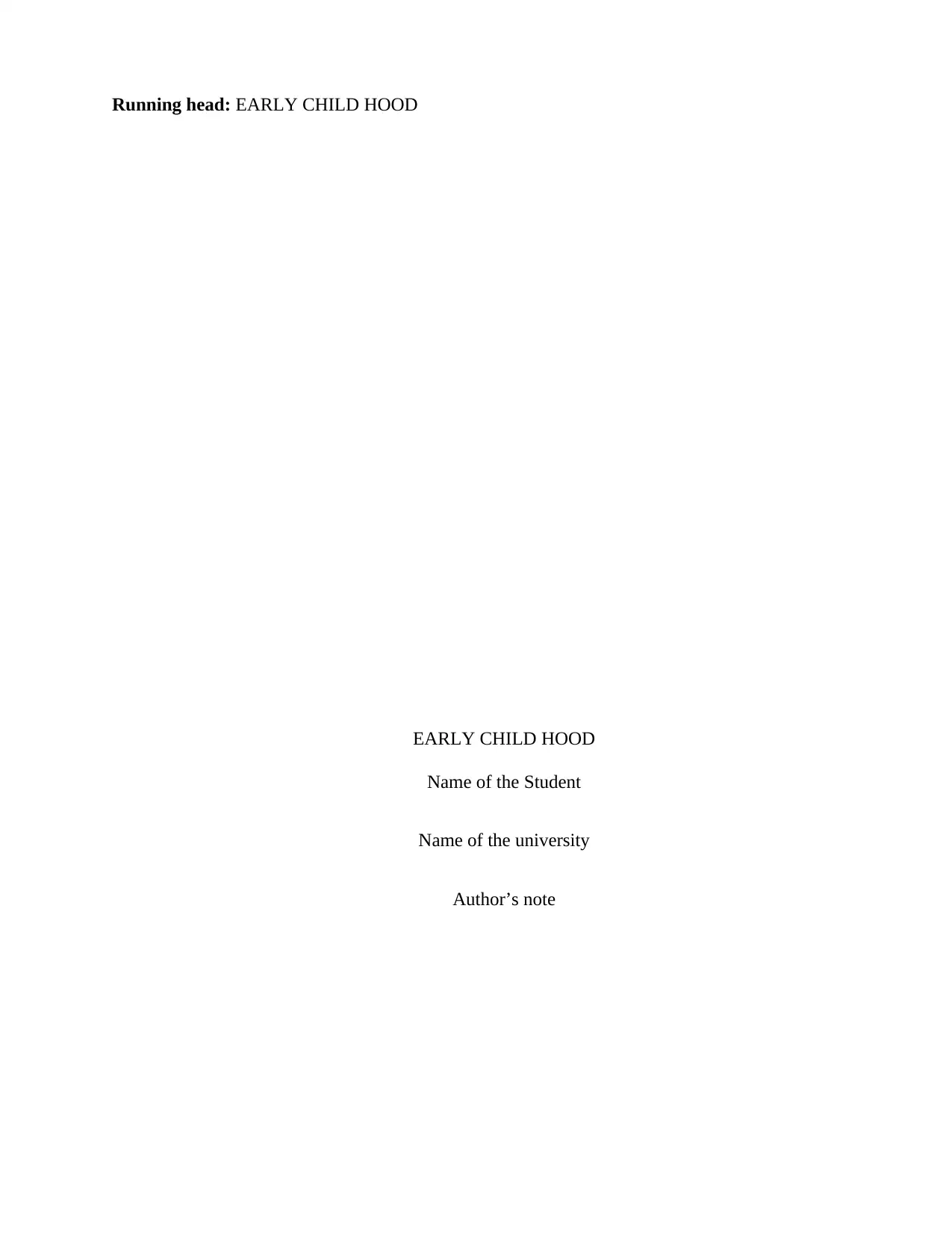
Running head: EARLY CHILD HOOD
EARLY CHILD HOOD
Name of the Student
Name of the university
Author’s note
EARLY CHILD HOOD
Name of the Student
Name of the university
Author’s note
Paraphrase This Document
Need a fresh take? Get an instant paraphrase of this document with our AI Paraphraser
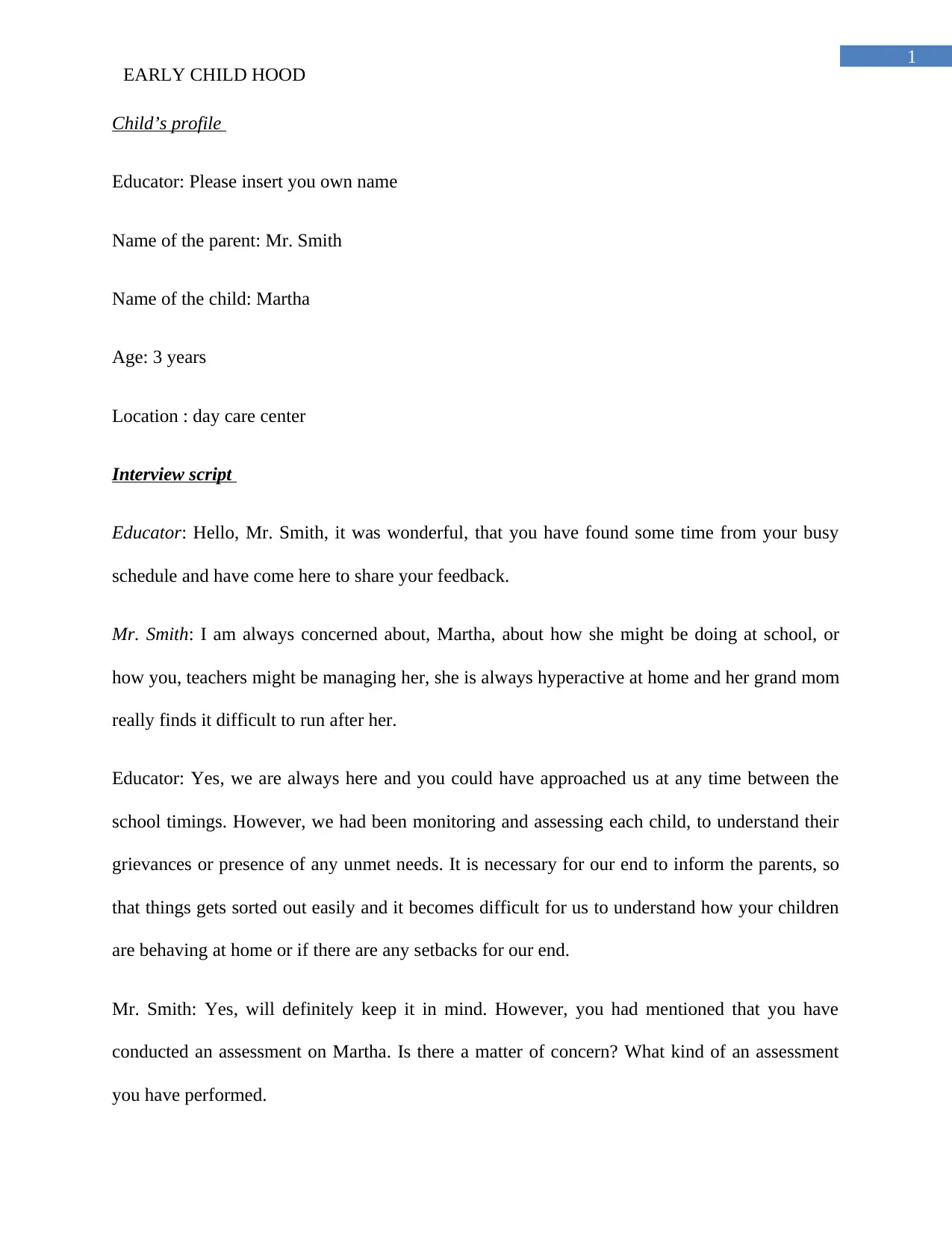
1
EARLY CHILD HOOD
Child’s profile
Educator: Please insert you own name
Name of the parent: Mr. Smith
Name of the child: Martha
Age: 3 years
Location : day care center
Interview script
Educator: Hello, Mr. Smith, it was wonderful, that you have found some time from your busy
schedule and have come here to share your feedback.
Mr. Smith: I am always concerned about, Martha, about how she might be doing at school, or
how you, teachers might be managing her, she is always hyperactive at home and her grand mom
really finds it difficult to run after her.
Educator: Yes, we are always here and you could have approached us at any time between the
school timings. However, we had been monitoring and assessing each child, to understand their
grievances or presence of any unmet needs. It is necessary for our end to inform the parents, so
that things gets sorted out easily and it becomes difficult for us to understand how your children
are behaving at home or if there are any setbacks for our end.
Mr. Smith: Yes, will definitely keep it in mind. However, you had mentioned that you have
conducted an assessment on Martha. Is there a matter of concern? What kind of an assessment
you have performed.
EARLY CHILD HOOD
Child’s profile
Educator: Please insert you own name
Name of the parent: Mr. Smith
Name of the child: Martha
Age: 3 years
Location : day care center
Interview script
Educator: Hello, Mr. Smith, it was wonderful, that you have found some time from your busy
schedule and have come here to share your feedback.
Mr. Smith: I am always concerned about, Martha, about how she might be doing at school, or
how you, teachers might be managing her, she is always hyperactive at home and her grand mom
really finds it difficult to run after her.
Educator: Yes, we are always here and you could have approached us at any time between the
school timings. However, we had been monitoring and assessing each child, to understand their
grievances or presence of any unmet needs. It is necessary for our end to inform the parents, so
that things gets sorted out easily and it becomes difficult for us to understand how your children
are behaving at home or if there are any setbacks for our end.
Mr. Smith: Yes, will definitely keep it in mind. However, you had mentioned that you have
conducted an assessment on Martha. Is there a matter of concern? What kind of an assessment
you have performed.
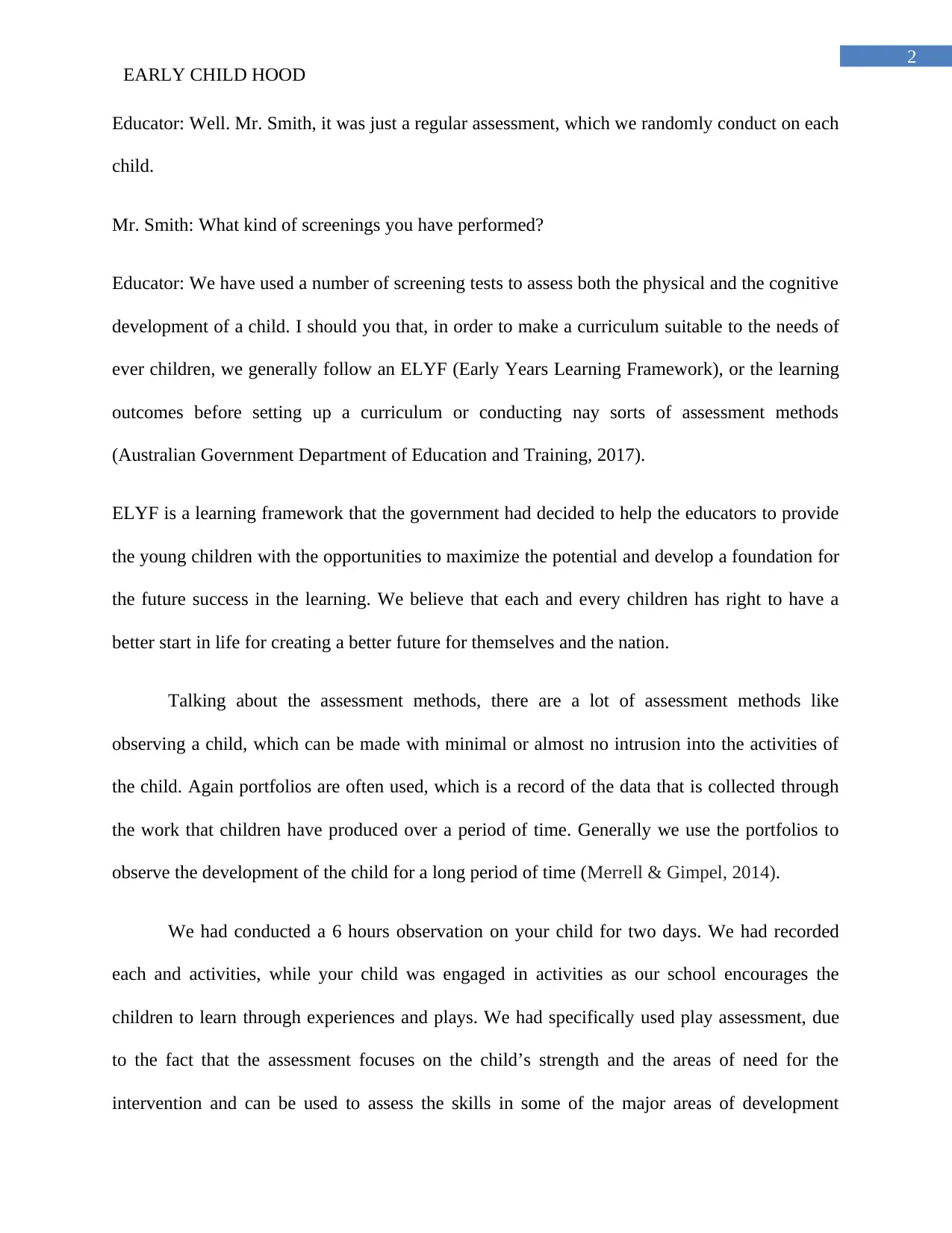
2
EARLY CHILD HOOD
Educator: Well. Mr. Smith, it was just a regular assessment, which we randomly conduct on each
child.
Mr. Smith: What kind of screenings you have performed?
Educator: We have used a number of screening tests to assess both the physical and the cognitive
development of a child. I should you that, in order to make a curriculum suitable to the needs of
ever children, we generally follow an ELYF (Early Years Learning Framework), or the learning
outcomes before setting up a curriculum or conducting nay sorts of assessment methods
(Australian Government Department of Education and Training, 2017).
ELYF is a learning framework that the government had decided to help the educators to provide
the young children with the opportunities to maximize the potential and develop a foundation for
the future success in the learning. We believe that each and every children has right to have a
better start in life for creating a better future for themselves and the nation.
Talking about the assessment methods, there are a lot of assessment methods like
observing a child, which can be made with minimal or almost no intrusion into the activities of
the child. Again portfolios are often used, which is a record of the data that is collected through
the work that children have produced over a period of time. Generally we use the portfolios to
observe the development of the child for a long period of time (Merrell & Gimpel, 2014).
We had conducted a 6 hours observation on your child for two days. We had recorded
each and activities, while your child was engaged in activities as our school encourages the
children to learn through experiences and plays. We had specifically used play assessment, due
to the fact that the assessment focuses on the child’s strength and the areas of need for the
intervention and can be used to assess the skills in some of the major areas of development
EARLY CHILD HOOD
Educator: Well. Mr. Smith, it was just a regular assessment, which we randomly conduct on each
child.
Mr. Smith: What kind of screenings you have performed?
Educator: We have used a number of screening tests to assess both the physical and the cognitive
development of a child. I should you that, in order to make a curriculum suitable to the needs of
ever children, we generally follow an ELYF (Early Years Learning Framework), or the learning
outcomes before setting up a curriculum or conducting nay sorts of assessment methods
(Australian Government Department of Education and Training, 2017).
ELYF is a learning framework that the government had decided to help the educators to provide
the young children with the opportunities to maximize the potential and develop a foundation for
the future success in the learning. We believe that each and every children has right to have a
better start in life for creating a better future for themselves and the nation.
Talking about the assessment methods, there are a lot of assessment methods like
observing a child, which can be made with minimal or almost no intrusion into the activities of
the child. Again portfolios are often used, which is a record of the data that is collected through
the work that children have produced over a period of time. Generally we use the portfolios to
observe the development of the child for a long period of time (Merrell & Gimpel, 2014).
We had conducted a 6 hours observation on your child for two days. We had recorded
each and activities, while your child was engaged in activities as our school encourages the
children to learn through experiences and plays. We had specifically used play assessment, due
to the fact that the assessment focuses on the child’s strength and the areas of need for the
intervention and can be used to assess the skills in some of the major areas of development
⊘ This is a preview!⊘
Do you want full access?
Subscribe today to unlock all pages.

Trusted by 1+ million students worldwide
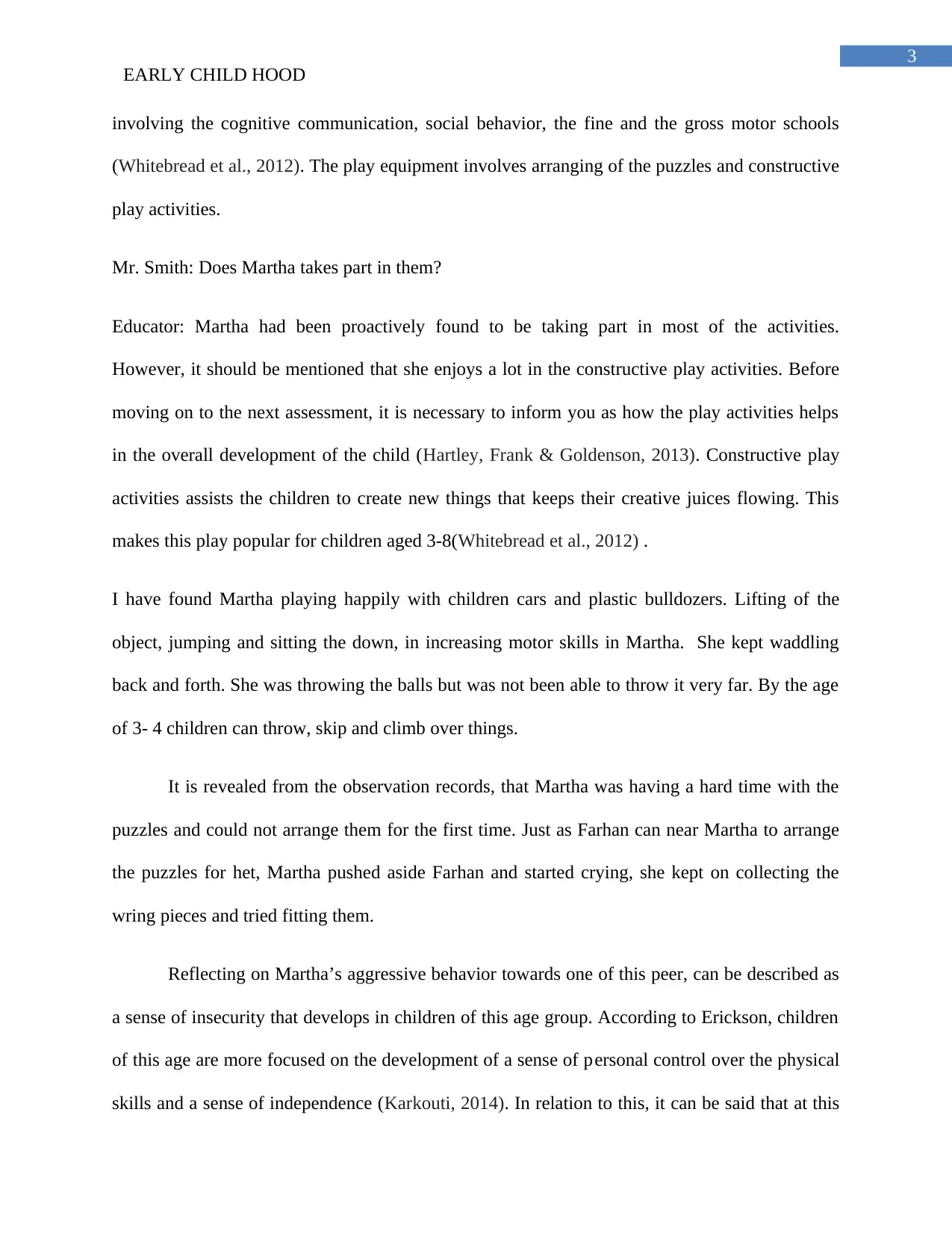
3
EARLY CHILD HOOD
involving the cognitive communication, social behavior, the fine and the gross motor schools
(Whitebread et al., 2012). The play equipment involves arranging of the puzzles and constructive
play activities.
Mr. Smith: Does Martha takes part in them?
Educator: Martha had been proactively found to be taking part in most of the activities.
However, it should be mentioned that she enjoys a lot in the constructive play activities. Before
moving on to the next assessment, it is necessary to inform you as how the play activities helps
in the overall development of the child (Hartley, Frank & Goldenson, 2013). Constructive play
activities assists the children to create new things that keeps their creative juices flowing. This
makes this play popular for children aged 3-8(Whitebread et al., 2012) .
I have found Martha playing happily with children cars and plastic bulldozers. Lifting of the
object, jumping and sitting the down, in increasing motor skills in Martha. She kept waddling
back and forth. She was throwing the balls but was not been able to throw it very far. By the age
of 3- 4 children can throw, skip and climb over things.
It is revealed from the observation records, that Martha was having a hard time with the
puzzles and could not arrange them for the first time. Just as Farhan can near Martha to arrange
the puzzles for het, Martha pushed aside Farhan and started crying, she kept on collecting the
wring pieces and tried fitting them.
Reflecting on Martha’s aggressive behavior towards one of this peer, can be described as
a sense of insecurity that develops in children of this age group. According to Erickson, children
of this age are more focused on the development of a sense of personal control over the physical
skills and a sense of independence (Karkouti, 2014). In relation to this, it can be said that at this
EARLY CHILD HOOD
involving the cognitive communication, social behavior, the fine and the gross motor schools
(Whitebread et al., 2012). The play equipment involves arranging of the puzzles and constructive
play activities.
Mr. Smith: Does Martha takes part in them?
Educator: Martha had been proactively found to be taking part in most of the activities.
However, it should be mentioned that she enjoys a lot in the constructive play activities. Before
moving on to the next assessment, it is necessary to inform you as how the play activities helps
in the overall development of the child (Hartley, Frank & Goldenson, 2013). Constructive play
activities assists the children to create new things that keeps their creative juices flowing. This
makes this play popular for children aged 3-8(Whitebread et al., 2012) .
I have found Martha playing happily with children cars and plastic bulldozers. Lifting of the
object, jumping and sitting the down, in increasing motor skills in Martha. She kept waddling
back and forth. She was throwing the balls but was not been able to throw it very far. By the age
of 3- 4 children can throw, skip and climb over things.
It is revealed from the observation records, that Martha was having a hard time with the
puzzles and could not arrange them for the first time. Just as Farhan can near Martha to arrange
the puzzles for het, Martha pushed aside Farhan and started crying, she kept on collecting the
wring pieces and tried fitting them.
Reflecting on Martha’s aggressive behavior towards one of this peer, can be described as
a sense of insecurity that develops in children of this age group. According to Erickson, children
of this age are more focused on the development of a sense of personal control over the physical
skills and a sense of independence (Karkouti, 2014). In relation to this, it can be said that at this
Paraphrase This Document
Need a fresh take? Get an instant paraphrase of this document with our AI Paraphraser
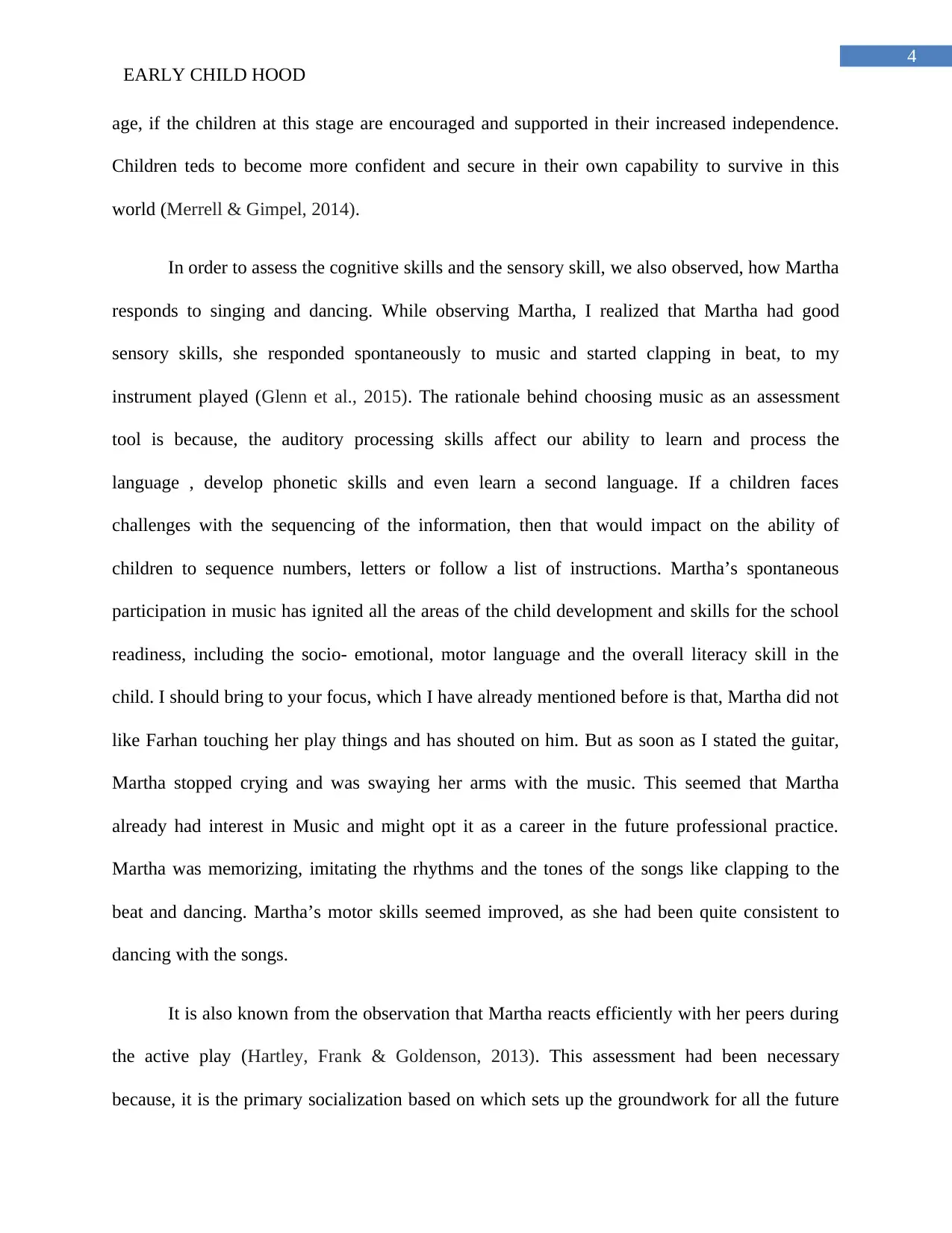
4
EARLY CHILD HOOD
age, if the children at this stage are encouraged and supported in their increased independence.
Children teds to become more confident and secure in their own capability to survive in this
world (Merrell & Gimpel, 2014).
In order to assess the cognitive skills and the sensory skill, we also observed, how Martha
responds to singing and dancing. While observing Martha, I realized that Martha had good
sensory skills, she responded spontaneously to music and started clapping in beat, to my
instrument played (Glenn et al., 2015). The rationale behind choosing music as an assessment
tool is because, the auditory processing skills affect our ability to learn and process the
language , develop phonetic skills and even learn a second language. If a children faces
challenges with the sequencing of the information, then that would impact on the ability of
children to sequence numbers, letters or follow a list of instructions. Martha’s spontaneous
participation in music has ignited all the areas of the child development and skills for the school
readiness, including the socio- emotional, motor language and the overall literacy skill in the
child. I should bring to your focus, which I have already mentioned before is that, Martha did not
like Farhan touching her play things and has shouted on him. But as soon as I stated the guitar,
Martha stopped crying and was swaying her arms with the music. This seemed that Martha
already had interest in Music and might opt it as a career in the future professional practice.
Martha was memorizing, imitating the rhythms and the tones of the songs like clapping to the
beat and dancing. Martha’s motor skills seemed improved, as she had been quite consistent to
dancing with the songs.
It is also known from the observation that Martha reacts efficiently with her peers during
the active play (Hartley, Frank & Goldenson, 2013). This assessment had been necessary
because, it is the primary socialization based on which sets up the groundwork for all the future
EARLY CHILD HOOD
age, if the children at this stage are encouraged and supported in their increased independence.
Children teds to become more confident and secure in their own capability to survive in this
world (Merrell & Gimpel, 2014).
In order to assess the cognitive skills and the sensory skill, we also observed, how Martha
responds to singing and dancing. While observing Martha, I realized that Martha had good
sensory skills, she responded spontaneously to music and started clapping in beat, to my
instrument played (Glenn et al., 2015). The rationale behind choosing music as an assessment
tool is because, the auditory processing skills affect our ability to learn and process the
language , develop phonetic skills and even learn a second language. If a children faces
challenges with the sequencing of the information, then that would impact on the ability of
children to sequence numbers, letters or follow a list of instructions. Martha’s spontaneous
participation in music has ignited all the areas of the child development and skills for the school
readiness, including the socio- emotional, motor language and the overall literacy skill in the
child. I should bring to your focus, which I have already mentioned before is that, Martha did not
like Farhan touching her play things and has shouted on him. But as soon as I stated the guitar,
Martha stopped crying and was swaying her arms with the music. This seemed that Martha
already had interest in Music and might opt it as a career in the future professional practice.
Martha was memorizing, imitating the rhythms and the tones of the songs like clapping to the
beat and dancing. Martha’s motor skills seemed improved, as she had been quite consistent to
dancing with the songs.
It is also known from the observation that Martha reacts efficiently with her peers during
the active play (Hartley, Frank & Goldenson, 2013). This assessment had been necessary
because, it is the primary socialization based on which sets up the groundwork for all the future
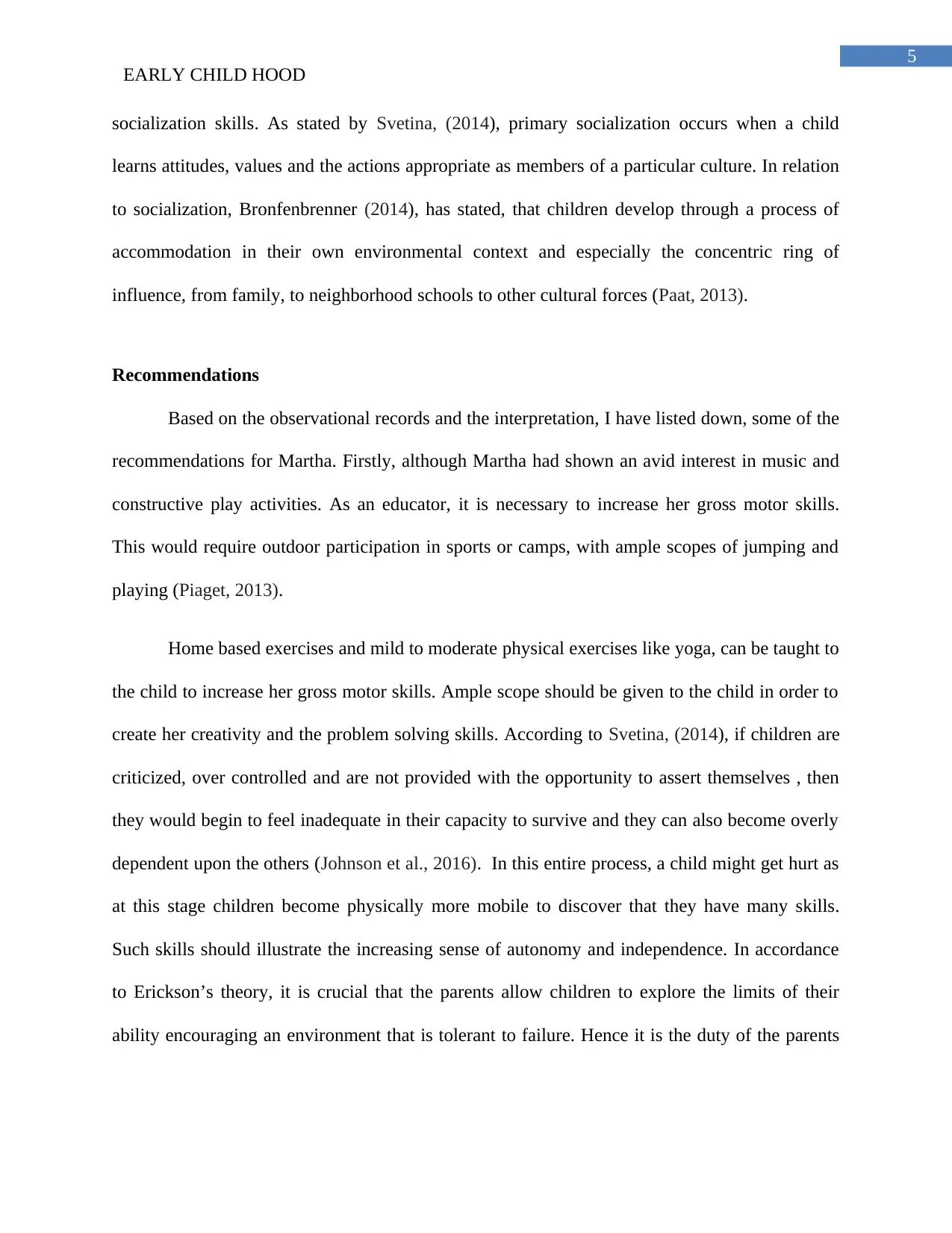
5
EARLY CHILD HOOD
socialization skills. As stated by Svetina, (2014), primary socialization occurs when a child
learns attitudes, values and the actions appropriate as members of a particular culture. In relation
to socialization, Bronfenbrenner (2014), has stated, that children develop through a process of
accommodation in their own environmental context and especially the concentric ring of
influence, from family, to neighborhood schools to other cultural forces (Paat, 2013).
Recommendations
Based on the observational records and the interpretation, I have listed down, some of the
recommendations for Martha. Firstly, although Martha had shown an avid interest in music and
constructive play activities. As an educator, it is necessary to increase her gross motor skills.
This would require outdoor participation in sports or camps, with ample scopes of jumping and
playing (Piaget, 2013).
Home based exercises and mild to moderate physical exercises like yoga, can be taught to
the child to increase her gross motor skills. Ample scope should be given to the child in order to
create her creativity and the problem solving skills. According to Svetina, (2014), if children are
criticized, over controlled and are not provided with the opportunity to assert themselves , then
they would begin to feel inadequate in their capacity to survive and they can also become overly
dependent upon the others (Johnson et al., 2016). In this entire process, a child might get hurt as
at this stage children become physically more mobile to discover that they have many skills.
Such skills should illustrate the increasing sense of autonomy and independence. In accordance
to Erickson’s theory, it is crucial that the parents allow children to explore the limits of their
ability encouraging an environment that is tolerant to failure. Hence it is the duty of the parents
EARLY CHILD HOOD
socialization skills. As stated by Svetina, (2014), primary socialization occurs when a child
learns attitudes, values and the actions appropriate as members of a particular culture. In relation
to socialization, Bronfenbrenner (2014), has stated, that children develop through a process of
accommodation in their own environmental context and especially the concentric ring of
influence, from family, to neighborhood schools to other cultural forces (Paat, 2013).
Recommendations
Based on the observational records and the interpretation, I have listed down, some of the
recommendations for Martha. Firstly, although Martha had shown an avid interest in music and
constructive play activities. As an educator, it is necessary to increase her gross motor skills.
This would require outdoor participation in sports or camps, with ample scopes of jumping and
playing (Piaget, 2013).
Home based exercises and mild to moderate physical exercises like yoga, can be taught to
the child to increase her gross motor skills. Ample scope should be given to the child in order to
create her creativity and the problem solving skills. According to Svetina, (2014), if children are
criticized, over controlled and are not provided with the opportunity to assert themselves , then
they would begin to feel inadequate in their capacity to survive and they can also become overly
dependent upon the others (Johnson et al., 2016). In this entire process, a child might get hurt as
at this stage children become physically more mobile to discover that they have many skills.
Such skills should illustrate the increasing sense of autonomy and independence. In accordance
to Erickson’s theory, it is crucial that the parents allow children to explore the limits of their
ability encouraging an environment that is tolerant to failure. Hence it is the duty of the parents
⊘ This is a preview!⊘
Do you want full access?
Subscribe today to unlock all pages.

Trusted by 1+ million students worldwide
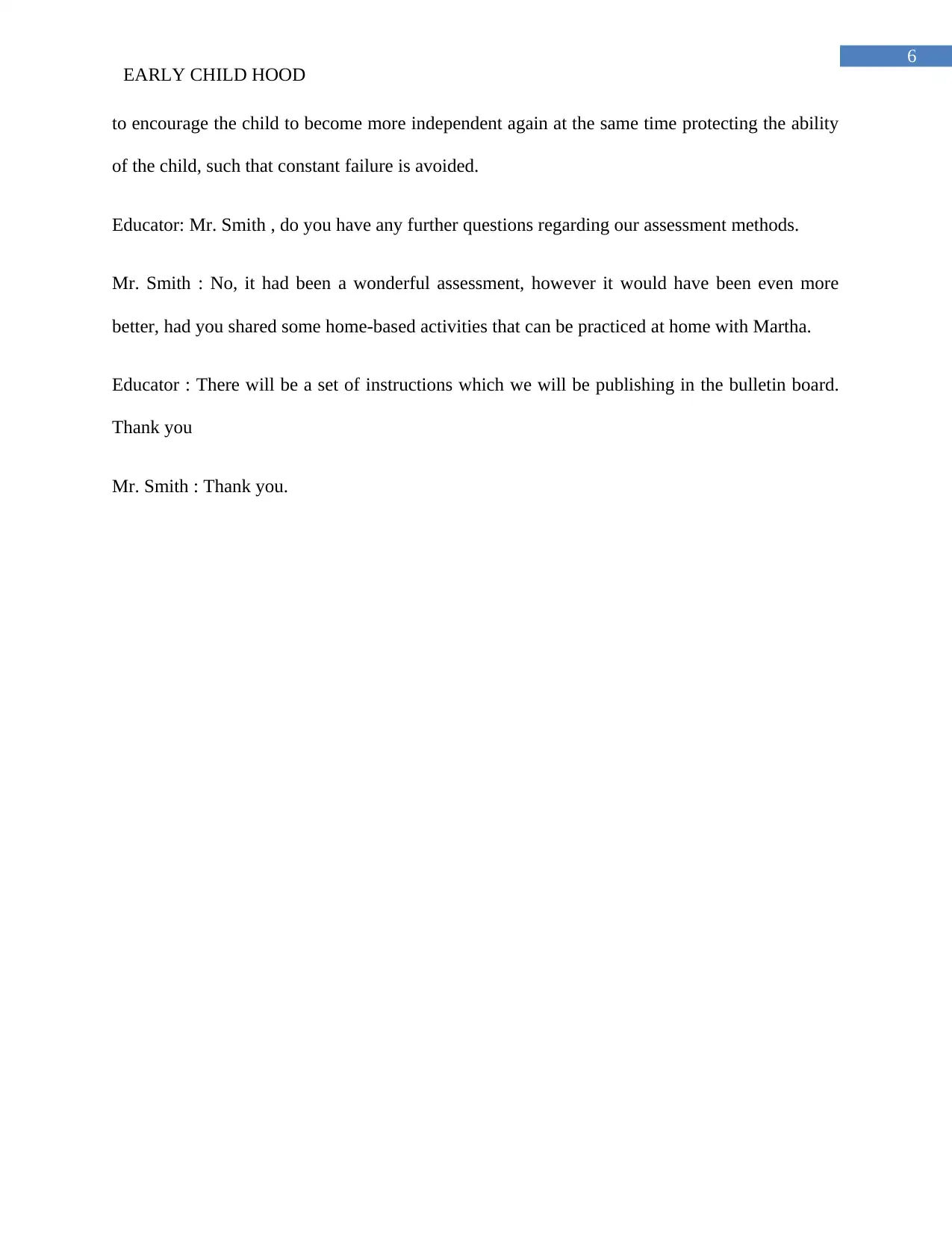
6
EARLY CHILD HOOD
to encourage the child to become more independent again at the same time protecting the ability
of the child, such that constant failure is avoided.
Educator: Mr. Smith , do you have any further questions regarding our assessment methods.
Mr. Smith : No, it had been a wonderful assessment, however it would have been even more
better, had you shared some home-based activities that can be practiced at home with Martha.
Educator : There will be a set of instructions which we will be publishing in the bulletin board.
Thank you
Mr. Smith : Thank you.
EARLY CHILD HOOD
to encourage the child to become more independent again at the same time protecting the ability
of the child, such that constant failure is avoided.
Educator: Mr. Smith , do you have any further questions regarding our assessment methods.
Mr. Smith : No, it had been a wonderful assessment, however it would have been even more
better, had you shared some home-based activities that can be practiced at home with Martha.
Educator : There will be a set of instructions which we will be publishing in the bulletin board.
Thank you
Mr. Smith : Thank you.
Paraphrase This Document
Need a fresh take? Get an instant paraphrase of this document with our AI Paraphraser
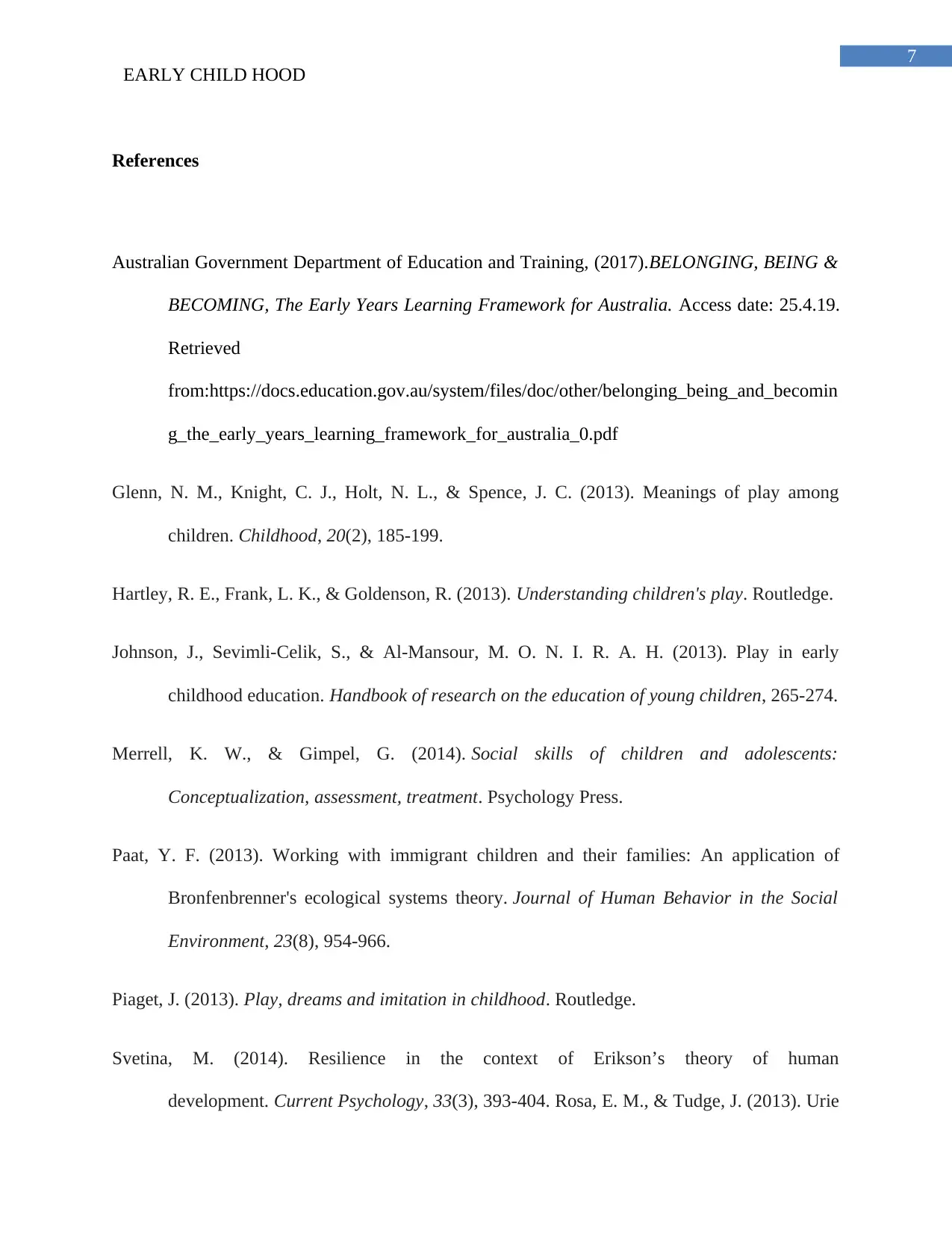
7
EARLY CHILD HOOD
References
Australian Government Department of Education and Training, (2017).BELONGING, BEING &
BECOMING, The Early Years Learning Framework for Australia. Access date: 25.4.19.
Retrieved
from:https://docs.education.gov.au/system/files/doc/other/belonging_being_and_becomin
g_the_early_years_learning_framework_for_australia_0.pdf
Glenn, N. M., Knight, C. J., Holt, N. L., & Spence, J. C. (2013). Meanings of play among
children. Childhood, 20(2), 185-199.
Hartley, R. E., Frank, L. K., & Goldenson, R. (2013). Understanding children's play. Routledge.
Johnson, J., Sevimli-Celik, S., & Al-Mansour, M. O. N. I. R. A. H. (2013). Play in early
childhood education. Handbook of research on the education of young children, 265-274.
Merrell, K. W., & Gimpel, G. (2014). Social skills of children and adolescents:
Conceptualization, assessment, treatment. Psychology Press.
Paat, Y. F. (2013). Working with immigrant children and their families: An application of
Bronfenbrenner's ecological systems theory. Journal of Human Behavior in the Social
Environment, 23(8), 954-966.
Piaget, J. (2013). Play, dreams and imitation in childhood. Routledge.
Svetina, M. (2014). Resilience in the context of Erikson’s theory of human
development. Current Psychology, 33(3), 393-404. Rosa, E. M., & Tudge, J. (2013). Urie
EARLY CHILD HOOD
References
Australian Government Department of Education and Training, (2017).BELONGING, BEING &
BECOMING, The Early Years Learning Framework for Australia. Access date: 25.4.19.
Retrieved
from:https://docs.education.gov.au/system/files/doc/other/belonging_being_and_becomin
g_the_early_years_learning_framework_for_australia_0.pdf
Glenn, N. M., Knight, C. J., Holt, N. L., & Spence, J. C. (2013). Meanings of play among
children. Childhood, 20(2), 185-199.
Hartley, R. E., Frank, L. K., & Goldenson, R. (2013). Understanding children's play. Routledge.
Johnson, J., Sevimli-Celik, S., & Al-Mansour, M. O. N. I. R. A. H. (2013). Play in early
childhood education. Handbook of research on the education of young children, 265-274.
Merrell, K. W., & Gimpel, G. (2014). Social skills of children and adolescents:
Conceptualization, assessment, treatment. Psychology Press.
Paat, Y. F. (2013). Working with immigrant children and their families: An application of
Bronfenbrenner's ecological systems theory. Journal of Human Behavior in the Social
Environment, 23(8), 954-966.
Piaget, J. (2013). Play, dreams and imitation in childhood. Routledge.
Svetina, M. (2014). Resilience in the context of Erikson’s theory of human
development. Current Psychology, 33(3), 393-404. Rosa, E. M., & Tudge, J. (2013). Urie
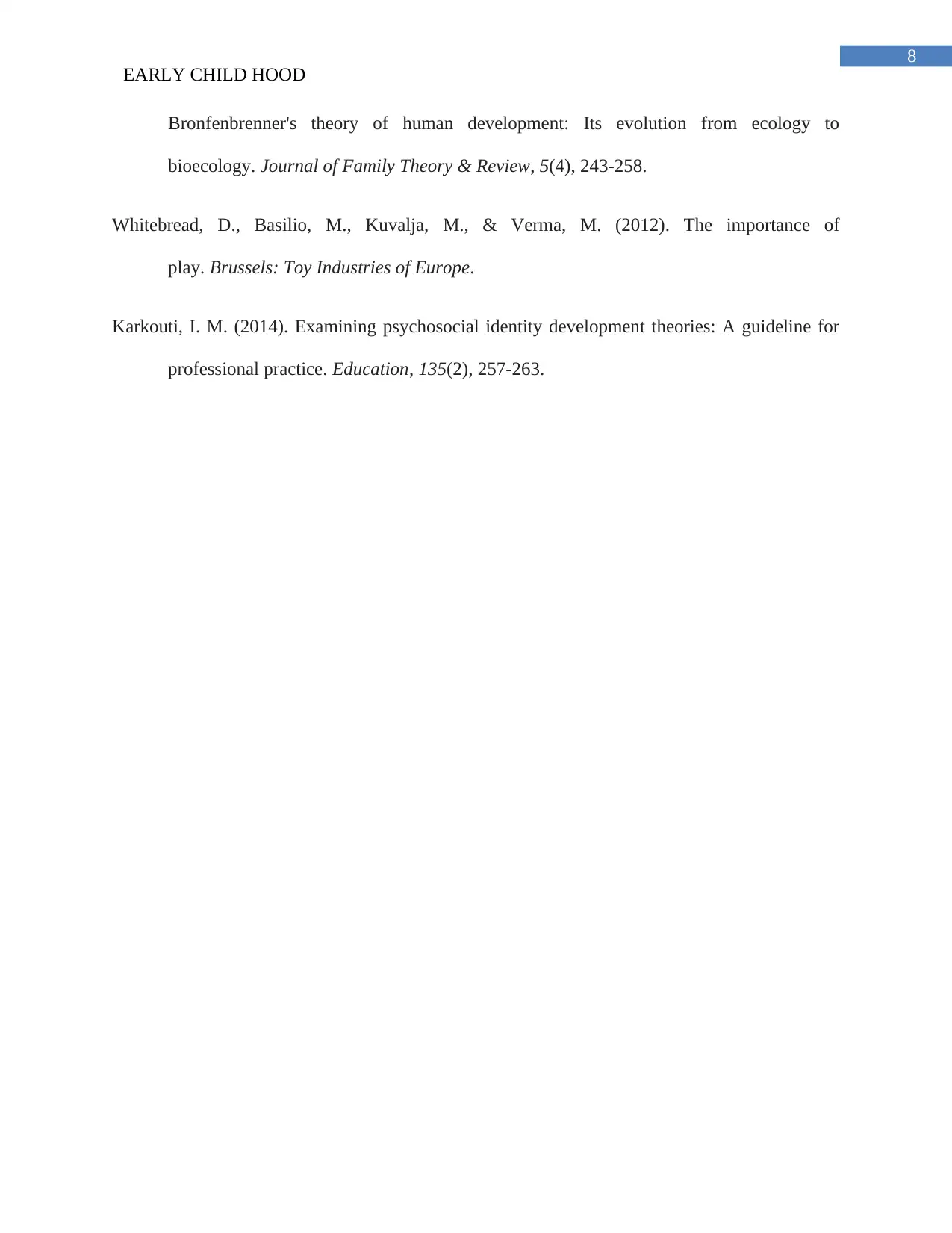
8
EARLY CHILD HOOD
Bronfenbrenner's theory of human development: Its evolution from ecology to
bioecology. Journal of Family Theory & Review, 5(4), 243-258.
Whitebread, D., Basilio, M., Kuvalja, M., & Verma, M. (2012). The importance of
play. Brussels: Toy Industries of Europe.
Karkouti, I. M. (2014). Examining psychosocial identity development theories: A guideline for
professional practice. Education, 135(2), 257-263.
EARLY CHILD HOOD
Bronfenbrenner's theory of human development: Its evolution from ecology to
bioecology. Journal of Family Theory & Review, 5(4), 243-258.
Whitebread, D., Basilio, M., Kuvalja, M., & Verma, M. (2012). The importance of
play. Brussels: Toy Industries of Europe.
Karkouti, I. M. (2014). Examining psychosocial identity development theories: A guideline for
professional practice. Education, 135(2), 257-263.
⊘ This is a preview!⊘
Do you want full access?
Subscribe today to unlock all pages.

Trusted by 1+ million students worldwide
1 out of 9
Related Documents
Your All-in-One AI-Powered Toolkit for Academic Success.
+13062052269
info@desklib.com
Available 24*7 on WhatsApp / Email
![[object Object]](/_next/static/media/star-bottom.7253800d.svg)
Unlock your academic potential
Copyright © 2020–2025 A2Z Services. All Rights Reserved. Developed and managed by ZUCOL.


